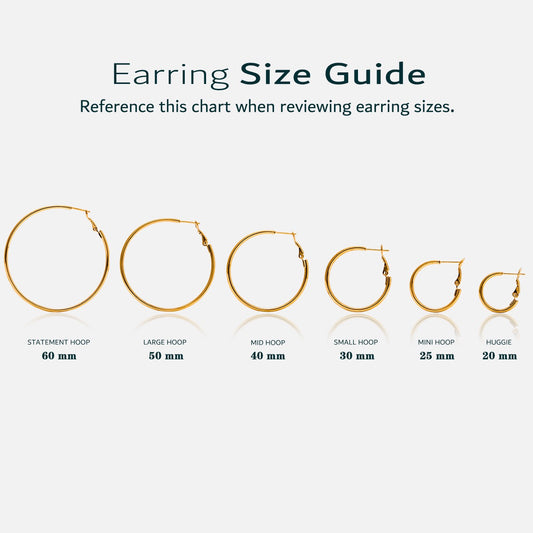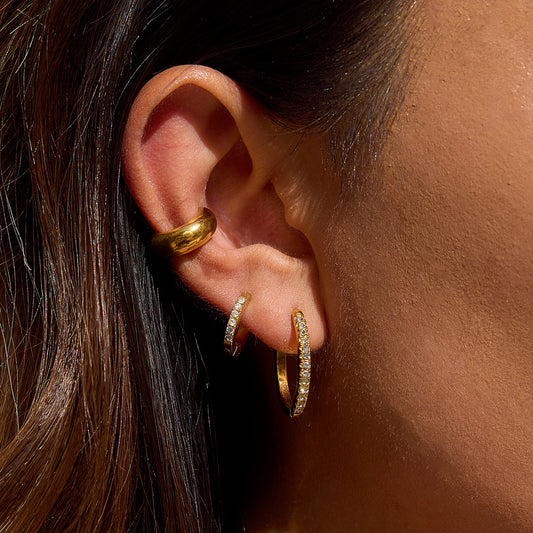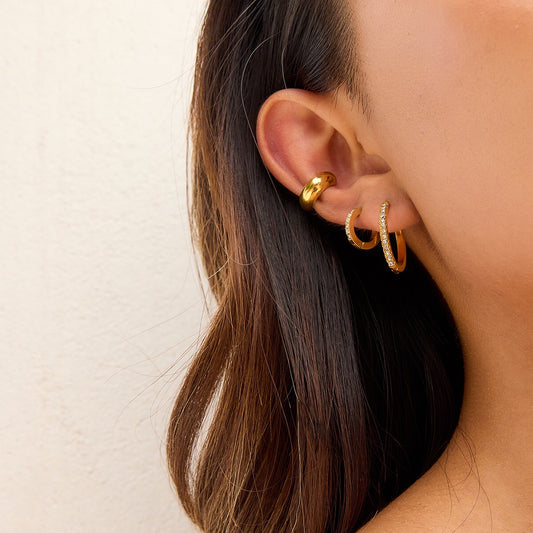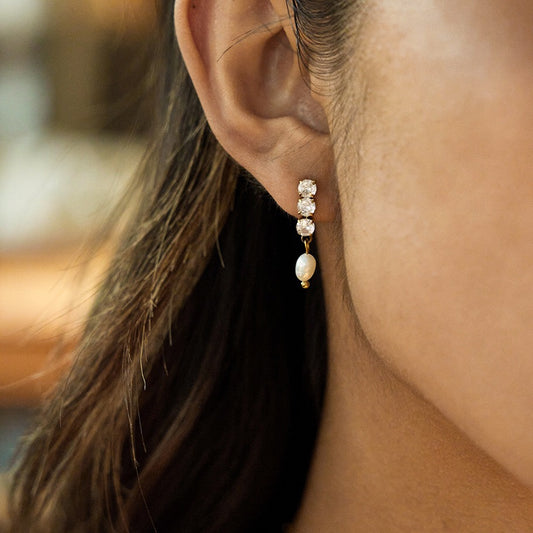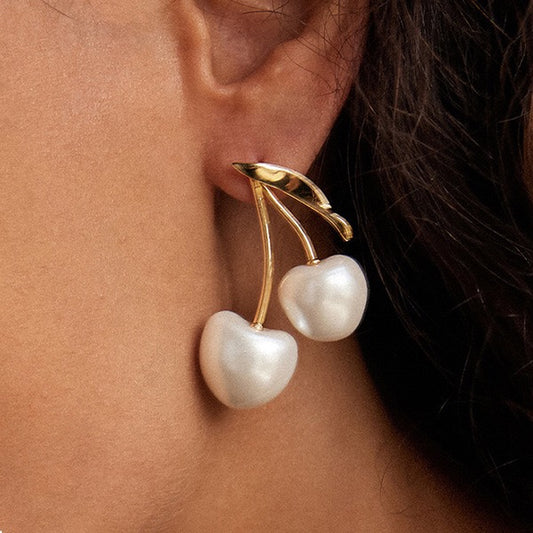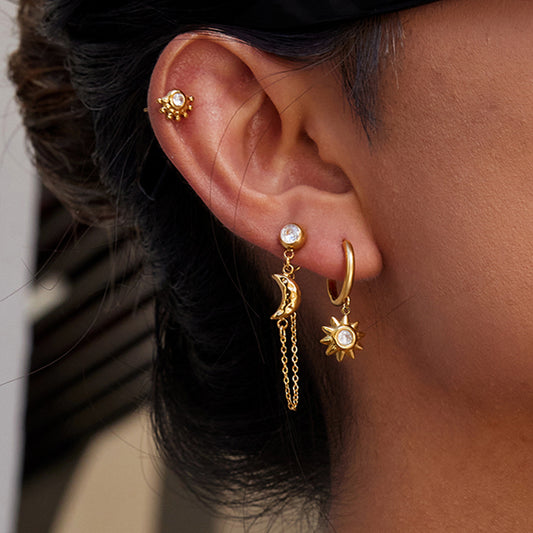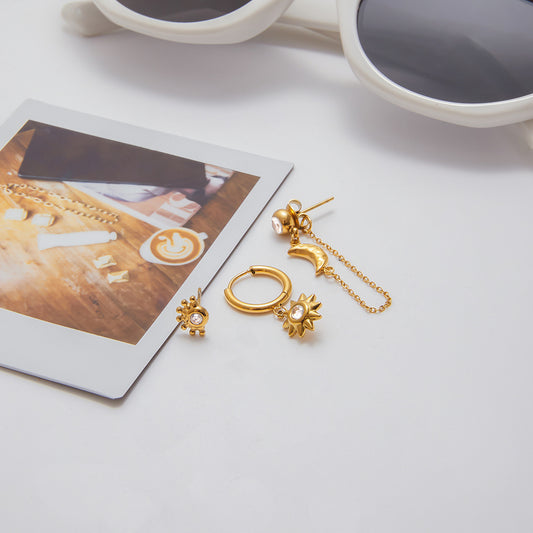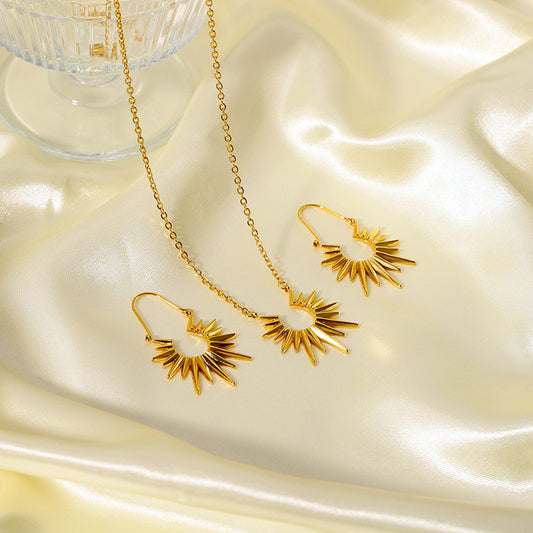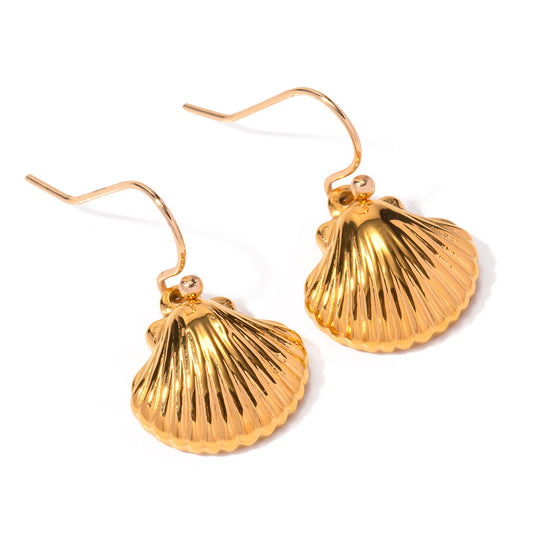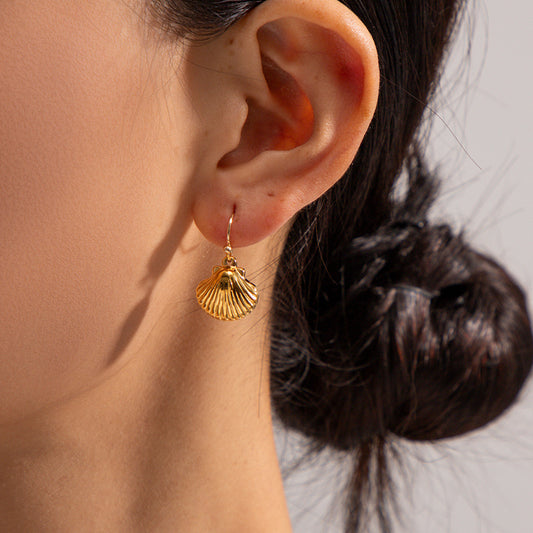Earrings for sensitive ears have become a game-changer for millions dealing with post-wear irritation. Unlike regular earrings that leave earlobes red, swollen, or itchy, earrings for sensitive ears are crafted with hypoallergenic materials that minimize irritation, letting you wear your favorite styles without discomfort. Whether you prefer studs, hoops, or dangles, these earrings blend comfort and fashion seamlessly. The global earring market was valued at approximately $25 billion in 2023 and is projected to reach $38 billion by 2032, with a compound annual growth rate (CAGR) of about 4.9%. In this guide, we’ll break down everything you need to know about earrings for sensitive ears—from their definition and popularity to styling tips, gifting ideas, and material FAQs.

What Are Earrings for Sensitive Ears?
Core Definition & Key Trait: Hypoallergenic Materials
Earrings for sensitive ears are specifically designed to reduce or eliminate irritation in people with reactive earlobes. Their defining feature is the use of hypoallergenic materials—substances that are less likely to trigger an allergic reaction (usually contact dermatitis) when in contact with skin. This sets them apart from standard earrings, which often contain nickel (a common allergen) or low-quality metals that corrode and irritate skin over time.
Crucially, “hypoallergenic” doesn’t mean “100% allergen-free”—it means the material has a very low risk of causing a reaction. For most sensitive-ear wearers, these materials (like titanium or sterling silver) are safe, though rare exceptions exist for those with extreme allergies.
How They Differ from Regular Earrings
Regular earrings and earrings for sensitive ears differ in three key ways:
-
Metal Composition: Regular earrings may use nickel, brass, or plated metals (which wear off to expose base metals), while sensitive-ear earrings rely on pure, non-reactive metals (e.g., titanium, 14k gold).
-
Craftsmanship: Sensitive-ear styles often have smooth, polished finishes to avoid rough edges that can irritate skin, and secure backings (like screw-backs) that don’t rub against lobes.
-
Testing: Many brands of earrings for sensitive ears undergo dermatological testing (e.g., approved by the AAD) to confirm their hypoallergenic properties, while regular earrings rarely do.

Why Are Earrings for Sensitive Ears So Popular?
Relief from Irritation: No More Red, Itchy Earlobes
The biggest driver of popularity is simple: comfort. A 2024 survey by jewelry brand Studs found that 82% of sensitive-ear wearers said they’d stopped wearing earrings entirely before discovering hypoallergenic options—frustrated by constant itching, swelling, or even blisters from standard styles. Earrings for sensitive ears let them reclaim their love of jewelry without the post-wear discomfort. For example, someone who couldn’t wear hoops before can now rock a titanium pair all day without irritation.
Versatility: Style Without Compromise
Gone are the days when sensitive-ear wearers were limited to plain, boring studs. Today’s earrings for sensitive ears come in every style imaginable—from dainty birthstone studs to bold statement hoops—so you never have to choose between comfort and fashion. They work for every occasion: casual outings, work, weddings, or date nights. This versatility means sensitive-ear wearers can keep up with trends (like layered earrings or huggie hoops) just like everyone else.
Inclusivity: For All Ages & Style Preferences
Earrings for sensitive ears appeal to a wide audience: teens getting their ears pierced for the first time (pediatricians often recommend hypoallergenic metals for new piercings), adults with long-term sensitivities, and even seniors with thinner, more reactive skin. They also cater to every style—minimalists love tiny titanium studs, while trendsetters opt for gold-plated hypoallergenic dangles. This inclusivity has made them a staple in jewelry collections worldwide.
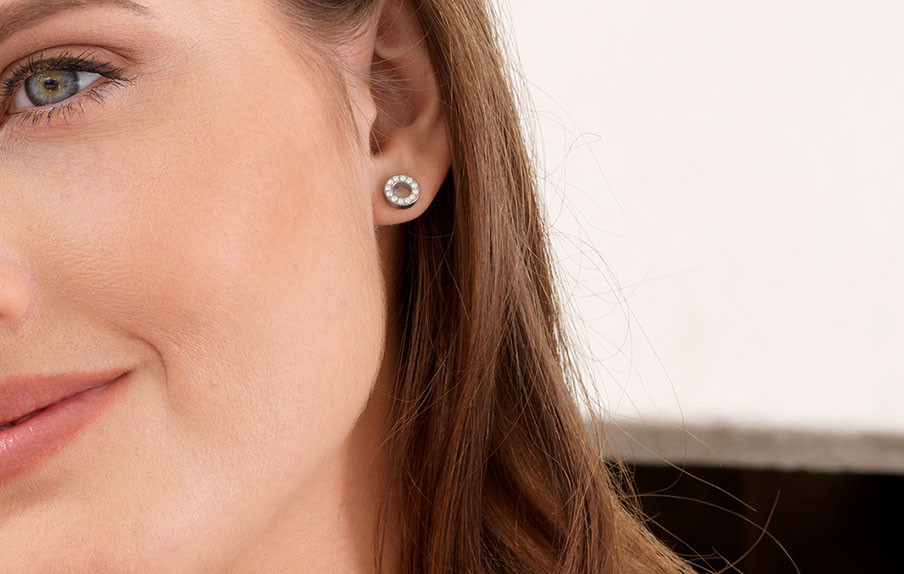
Popular Styles of Earrings for Sensitive Ears
Stud Earrings: Minimalist & Daily-Friendly
Studs are the most popular style for sensitive ears—they’re low-profile, comfortable, and easy to wear all day. Top options include:
-
Birthstone Studs: Crafted from hypoallergenic metals (titanium, sterling silver) with gemstones (e.g., sapphires, rubies) set in secure prongs. Perfect for adding a pop of color to casual or work outfits.
-
Mini Hoops (Huggies): Small, tight-fitting hoops (10–15mm) made from hypoallergenic materials. They’re more versatile than large hoops and stay in place during daily activities (e.g., working out, commuting).
-
Symbol Studs: Tiny designs like hearts, stars, or initials—great for personalizing your look without irritation. Many brands offer these in mixed metals (silver + gold) for added style.
Dangle Earrings: For Special Occasions
Dangle earrings add elegance to formal outfits and come in hypoallergenic options that won’t weigh down lobes:
-
Gemstone Dangles: Short (1–2 inch) dangles with small gemstones or cubic zirconia (CZ) set in hypoallergenic metal. They sparkle without causing irritation—ideal for weddings or date nights.
-
Tassel Dangles: Soft, lightweight tassels attached to hypoallergenic hooks. Made from fabric or metallic threads, they’re trendy and comfortable for hours of wear.
-
Drop Earrings: Simple, single-gem drop styles (e.g., a pearl or CZ hanging from a thin chain). They’re understated enough for work events but dressy enough for parties.

Hoop Earrings: Bold & Timeless
Hoops are a classic, and hypoallergenic versions let sensitive-ear wearers enjoy them too:
-
Medium Hoops (20–30mm): Made from thick, durable hypoallergenic metal (e.g., 14k gold, stainless steel). They’re bold enough to make a statement but not so large that they tug on lobes.
-
Thin Hoops: Delicate, 1–2mm thick hoops in hypoallergenic silver or gold. Perfect for layering with studs or wearing alone for a minimalist look.
-
Embellished Hoops: Hoops with small CZ or enamel accents (e.g., a row of tiny CZs along the edge). They add sparkle without the risk of irritation from nickel-plated details.
How to Wear Earrings for Sensitive Ears
Daily Wear: Comfort First
For everyday wear, prioritize comfort and simplicity:
-
Choose Lightweight Styles: Avoid heavy dangles or large hoops that can pull on lobes—stick to studs, huggies, or small hoops.
-
Match to Outfits: Pair titanium or silver studs with casual looks (jeans + tee) or workwear (blazers + slacks). Gold-plated huggies complement warm tones (browns, oranges) in fall outfits.
-
Keep It Minimal: If you have multiple piercings, mix 2–3 small hypoallergenic styles (e.g., a stud in the first piercing, a tiny huggie in the second) to avoid overcrowding.

Special Occasions: Dress It Up
For weddings, parties, or events, elevate your look with these tips:
-
Layer Studs & Dangles: Wear a small stud in your first piercing and a short dangle in the second—this adds depth without irritation.
-
Opt for Sparkle: Choose hypoallergenic CZ or gemstone earrings (e.g., diamond-like CZ studs) to match formal dresses.
-
Stick to Secure Backings: Use screw-back or lever-back earrings instead of push-backs—they stay in place during dancing or photos.
Layering for Trendy Looks
Layered earrings are a top trend, and sensitive-ear wearers can join in with these tricks:
-
Mix Sizes: Pair a tiny stud (3mm) with a slightly larger huggie (12mm) in the same metal for a cohesive look.
-
Match Metals: Stick to one metal family (all silver, all gold) to avoid clashing—hypoallergenic metals come in both, so you have options.
-
Avoid Overlapping: Ensure earrings don’t rub against each other (this can cause irritation)—leave a small gap between piercings.
Earrings for Sensitive Ears: Perfect Gift for Your Girlfriend
Why It Resonates as a Girlfriend Gift
Earrings for sensitive ears make a thoughtful gift for your girlfriend—especially if she’s mentioned struggling with irritation from regular jewelry. Here’s why it works:
-
It’s Practical: You’re giving her something she can actually wear (unlike a generic necklace that might irritate her skin). A 2024 survey by Jewelry Box found that 76% of women said “useful, wearable gifts” were their favorite from partners.
-
It Shows You Listen: Remembering she has sensitive ears (and choosing a gift that addresses that) proves you pay attention to her needs and preferences.
-
It’s Stylish: With so many trendy styles available, you can pick a pair that matches her taste—whether she loves minimalism or bold statements.
Tips for Choosing the Right Pair
-
Know Her Style:
-
Minimalists: Tiny titanium or silver studs (hearts, initials) or thin huggies.
-
Trendsetters: Gold-plated tassel dangles or embellished hoops.
-
Classic Lovers: Pearl or CZ studs in hypoallergenic metal.
-
Check Her Metal Preference:
Notice what she already wears—if she loves silver jewelry, choose sterling silver or titanium; if she favors gold, go for 14k gold-plated hypoallergenic earrings.
-
Consider the Occasion:
-
For birthdays: A pair of birthstone studs (her birth month or a meaningful month, like your anniversary).
-
For holidays: Sparkly CZ dangles (great for Christmas parties or New Year’s Eve).
-
“Just Because”: A simple pair of huggies she can wear daily.
-
Add a Personal Touch:
Pair the earrings with a handwritten note (e.g., “I noticed you couldn’t wear your old hoops—hope these let you rock your favorite style without irritation!”) to make the gift extra special.
How to Clean Earrings for Sensitive Ears
At-Home Cleaning Methods (By Material)
Proper cleaning keeps hypoallergenic earrings in good condition and prevents buildup that can cause irritation. Here’s how to clean common materials:
-
Titanium/Stainless Steel: Mix warm water with mild dish soap. Dip a soft-bristled toothbrush (or cotton swab for small details) into the solution and gently scrub the earrings. Rinse with clean water and dry with a lint-free cloth. For extra shine, wipe with a microfiber cloth.
-
Sterling Silver: Use a silver polishing cloth (avoid harsh silver cleaners, which can strip the metal). For tarnish, mix 1 cup warm water with 1 teaspoon baking soda—dip a cloth into the solution and gently rub the earrings, then rinse and dry.
-
Gold-Plated Hypoallergenic: Wipe with a damp microfiber cloth to remove dirt and oils. Avoid soaking (water can wear down the plating) and never use polish (it will scratch the gold).
-
Gemstone/CZ Earrings: Wipe gemstones with a soft cloth to remove smudges. For deeper cleaning, use a cotton swab dipped in soapy water to clean around the setting—avoid soaking porous stones (like pearls) in water.
Maintenance Tips to Prevent Irritation
-
Clean Before First Wear: Even new hypoallergenic earrings can have residue from manufacturing—wipe them with alcohol or soapy water before putting them in.
-
Remove Before Activities: Take earrings out before swimming (chlorine can damage metal) or showering (water can cause buildup).
-
Store Properly: Keep earrings in a dry, clean jewelry box—separate them from other jewelry to avoid scratches. For studs, use a jewelry tray with small compartments to keep backings from getting lost.
-
Clean After Wear: Wipe earrings with a dry cloth after taking them off to remove skin oils—this prevents buildup that can irritate ears next time you wear them.
What Earrings Are Best for Sensitive Ears?
Top Hypoallergenic Materials to Look For
The best earrings for sensitive ears are made from these non-reactive materials:
-
Titanium: The most hypoallergenic metal—resistant to corrosion, lightweight, and safe for even the most sensitive skin. It’s often used in medical implants (like pacemakers), so it’s trusted for long-term wear.
-
14k Gold or Higher: Pure gold (24k) is too soft for earrings, but 14k or 18k gold (mixed with small amounts of non-reactive metals like copper or silver) is hypoallergenic. Avoid 10k gold (it has more nickel).
-
Sterling Silver (925): 92.5% pure silver mixed with 7.5% other metals (usually copper). It’s hypoallergenic for most people, though those with extreme copper allergies may need to avoid it.
-
Platinum: A rare, durable metal that’s hypoallergenic and doesn’t tarnish. It’s more expensive than titanium or silver but lasts a lifetime.
Red Flags to Avoid
Steer clear of earrings made with these materials, which often trigger irritation:
-
Nickel: Found in most cheap jewelry (costume earrings, fast-fashion styles). Even “nickel-free” labeled earrings may have trace amounts—opt for “nickel-safe” or dermatologist-tested instead.
-
Brass/Copper (Unplated): These metals corrode easily, leaving green residue on skin and causing irritation.
-
Thin Plating: Gold-plated or silver-plated earrings with thin plating (less than 1 micron) will wear off quickly, exposing the base metal (often nickel) underneath.
Are Plastic Earrings Good for Sensitive Ears?
Short Answer: It Depends on the Plastic Type
Plastic earrings can be good for sensitive ears, but not all plastics are created equal:
-
Good Plastic Options: Medical-grade plastic (e.g., acrylic, Teflon) or bioplastic (made from plant-based materials) is hypoallergenic and safe for sensitive skin. These are often used for kids’ earrings or new piercings, as they’re lightweight and non-reactive.
-
Bad Plastic Options: Cheap, low-quality plastic (e.g., vinyl, PVC) can contain chemicals (like phthalates) that leach into skin and cause irritation. These earrings also tend to trap moisture (from sweat), leading to bacterial growth and infections.
Pros & Cons of Plastic Earrings
-
Pros: Affordable, lightweight, available in fun colors/designs, and safe for new piercings (when medical-grade).
-
Cons: Less durable than metal (can break or warp), may trap moisture, and limited style options for formal occasions.
When to Choose Plastic Earrings
Plastic earrings are ideal for:
-
Kids with sensitive ears (medical-grade acrylic is gentle and easy to clean).
-
New piercings (doctors often recommend plastic to avoid metal irritation during healing).
-
Casual, temporary looks (e.g., colorful studs for a beach day).
Are Stainless Steel Earrings Good for Sensitive Ears?
Short Answer: Yes—High-Quality Stainless Steel Is a Great Option
Stainless steel earrings are excellent for sensitive ears, but only if they’re 316L surgical-grade stainless steel (the highest quality for jewelry). Here’s why:
-
Non-Reactive: 316L stainless steel contains chromium and nickel, but the nickel is bonded tightly to the metal—preventing it from leaching into skin. This makes it hypoallergenic for 99% of sensitive-ear wearers.
-
Durable: Resistant to rust, tarnish, and scratches—perfect for daily wear. It’s also easy to clean (just soap and water).
-
Affordable: More budget-friendly than titanium or gold, making it a great entry point for sensitive-ear jewelry.
What to Avoid
Steer clear of 304 stainless steel (used in kitchenware or cheap jewelry)—it has more nickel and less chromium, making it more likely to cause irritation. Always check for “316L surgical-grade” on the product label.
Are Titanium Earrings Good for Sensitive Ears?
Short Answer: Yes—Titanium Is One of the Best Options for Sensitive Ears
Titanium earrings are widely regarded as the gold standard for sensitive ears, and for good reason:
-
Extremely Hypoallergenic: Titanium contains no nickel, and its smooth surface doesn’t react with skin oils or sweat. It’s used in medical implants (like joint replacements) because of its biocompatibility—making it safe for even those with severe metal allergies.
-
Lightweight & Comfortable: Much lighter than stainless steel or gold, so it doesn’t tug on lobes—ideal for daily wear or large styles (like hoops).
-
Durable & Tarnish-Resistant: Doesn’t rust, fade, or scratch—titanium earrings can last decades with proper care.
Pros & Cons of Titanium Earrings
-
Pros: Hypoallergenic for almost everyone, lightweight, durable, and available in neutral tones (silver, gray) that match any outfit.
-
Cons: More expensive than stainless steel, and limited color options (most are silver-toned, though some brands offer gold-plated titanium).
When to Choose Titanium Earrings
Titanium earrings are perfect for:
-
People with severe metal allergies: If you’ve reacted to stainless steel or even sterling silver, titanium is likely to be safe—its biocompatibility makes it one of the least reactive metals available.
-
Daily wear: Their lightweight design and durability mean you can leave them in for days (or even weeks) without discomfort, making them great for busy lifestyles.
-
Large or statement styles: If you love hoops or dangle earrings but worry about weight pulling on lobes, titanium’s lightness lets you wear bold designs without irritation.
-
New piercings: Many piercers recommend titanium for initial piercings (earlobes, cartilage) because it minimizes healing irritation and reduces the risk of infection.
Bonus: Tips for Buying Earrings for Sensitive Ears
To ensure you pick the right pair (and avoid hidden irritants), keep these tips in mind:
1. Check Labels Carefully
Don’t just rely on “hypoallergenic” wording—look for specific material labels like:
-
“316L surgical-grade stainless steel”
-
“Titanium (pure or medical-grade)”
-
“14k gold or higher”
-
“Sterling silver (925)”
Brands that list exact materials (not just vague claims) are more trustworthy, as they’re transparent about what’s in the earrings.
2. Test Before Committing (If Possible)
If shopping in-store, ask to try on a sample pair (many jewelers have display earrings for sensitive ears). Wear them for 10–15 minutes—if you feel any itching or warmth, they may not be a good fit. For online purchases, choose brands with free return policies (e.g., Studs, Mejuri) so you can return them if they irritate your ears.
3. Avoid “Mystery Metals”
Steer clear of earrings labeled with vague terms like “fashion metal,” “costume jewelry,” or “mixed metals”—these often contain nickel or low-quality alloys that trigger reactions. Even if they’re cheap, they’ll end up unused if they irritate your skin.
4. Prioritize Quality Over Price
While hypoallergenic earrings may cost more than fast-fashion styles, they’re a worthwhile investment. A \(20 pair of titanium studs will last years and be worn regularly, while a \)5 nickel pair will cause irritation and end up in a drawer.
Conclusion: Earrings for Sensitive Ears—Wear Comfort, Embrace Style
For anyone tired of choosing between style and comfort, earrings for sensitive ears are a revelation. They let you enjoy the joy of jewelry without the frustration of red, itchy lobes—whether you’re rocking daily studs, party-ready dangles, or timeless hoops. With materials like titanium, surgical-grade stainless steel, and 14k gold, there’s a hypoallergenic option for every style, budget, and occasion.
And let’s not forget their gifting power: a pair of earrings for sensitive ears says you care about both their style and their comfort—a thoughtful gesture that will be appreciated every time they wear them. Whether it’s for your girlfriend’s birthday, a holiday, or just because, these earrings aren’t just an accessory—they’re a way to help someone feel confident and comfortable in their own skin.
Ready to find your perfect pair? Start by:
-
Identifying your material match: If you have severe allergies, start with titanium; if you’re on a budget, try 316L stainless steel.
-
Browsing trusted brands: Check out brands like Studs (trendy styles), Mejuri (minimalist designs), or Pandora (classic options)—all offer curated collections for sensitive ears.
-
Trying a small style first: If you’re new to hypoallergenic jewelry, start with tiny studs or huggies—they’re easy to wear daily and let you test the material.
Don’t let sensitive ears hold you back from wearing the jewelry you love. With earrings for sensitive ears, you can have it all: no itch, all style. Start shopping today, and rediscover the joy of wearing earrings that feel as good as they look.




